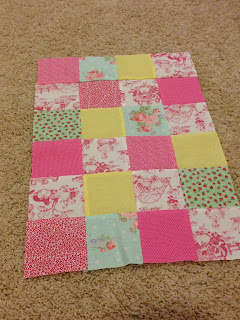As part of my teaching philosophy, I write: "I want to forever remember what it feels like to be a new learner, and admit that I’ll never be in the exact position as my students."
I may not be able to hit rewind on my understanding of Intro to Mass Communication, but I can place myself in the vulnerable position of approaching an unfamiliar topic or task. So begins my quilting adventure.
 |
| My tiny helper and her quilt topper. |
I'm immediately reminded that every topic has its own vocabulary. Have you ever "stitched in the ditch" or bought a "walking foot"? I had to look up so much just to understand what the online tutorials mentioned. I needed the online tutorial for the online tutorial. Our students feel this way when we start yammering on about any topic for the first exposure. This brings me to pacing.
Instead of zipping right along, I am having to move at a much slower pace. I read and re-read my instructions. Hesitation happens. The confidence I feel with well-known tasks and topics is not there. I struggle with the tools, too. Every bump in the road seems much larger than it might be for the experienced quilter. So imagine if our students are trying something new AND they are new to BlackBoard or a social media tool AND they experience setbacks.
 |
| Quilt topper for Little One's doll crib. |
As a beginning quilter, I want to see progress. Our students want the same kind of validation and assurance that they are on the right path. Maybe more checkpoints or self-checks are in order for brand new topics and tasks. And more self-help videos.
I would be lost without the quilters who have taken the time to post how-to's on YouTube. Some are better than others, but getting to see the process in action and being able to replay, replay and replay has helped me to understand quilting concepts. The take-away for me is to create more help videos of my own and develop curated lists of better videos for students.
How is the quilt, you ask? I'm starting small, a quilt for a doll crib. I have the topper complete and will now actually quilt (after I buy more supplies!). I'll let you know how it goes. What do you do to remind yourself of how our students might feel?









